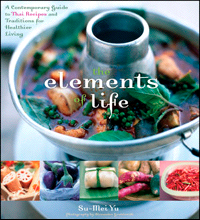The cover photos by Alexandra Grablewski on Su-Mei Yu‘s The Elements of Life (Wiley 2011) speak volumes about the contents. Below a pot of Jungle Soup (p. 128) brimming with kefir leaves and green spices, are five photographs – each showing a different color – orange lotus roots, purple eggplants, a white and green Crab Wrap (p. 282), pink roots, and red chilis. The Elements of Life is both a primer on food as way to spiritual and healthy well-being, but also a wonderful cookbook. Su-Mei is a follower of Dr. Pennapa Subcharoen, who taught her about balancing the four elements: earth, water, wind, and fire. Many cultures believe in the healing power of food – from chicken soup to spicy dishes. The heart of the philosophy is about understanding the balance between the natural environment and our human bodies.
The first chapter in the book goes over a wheel that you can use to find your home element and what that means. Using your birthdate, you can calculate under what element you fall, and use that knowledge to choose dishes in the rest of the book.
I now understand why certain tastes, flavors, and aromas are right for me. I avoid foods that can aggravate my body, especially when I am anxious and nervous. I know why I crave certain foods when the weather turns cold and damp and that it is important for me to cook extra-nurturing foods when there is a sudden change in the weather. (p. xii)
The next chapter is for everyone –all elements. It includes basics like Almond Milk (p. 21), Chicken Broth (p. 26) with daikon and star anise, and Fish Broth (p. 28) with garlic, ginger, and lemongrass.
The rest of the chapter is filled with Thai and non-Thai recipes for all meals, like breakfast dishes – Rice and Banana Pancakes with Seasonal Fruit Mix (p. 31) and Thai-Style Omelet with Tomato, Celery, and Tofu (p. 37). At the bottom of the page are variations for each element: Wind gets celery, onions, sweet peppers, mushrooms, and Thai basil, while Fire gets mushrooms, broccoli, fennel, and tarragon.
 For different salad dressings, she offers alternatives for salad for each element as well. For instance, the Black Sesame Dressing (p. 55) goes on tofu, pork tenderloin, fennel, and apple for an Earth person, while a Water person gets shrimp, oranges, watercress and almonds with a few more ingredients for each.
For different salad dressings, she offers alternatives for salad for each element as well. For instance, the Black Sesame Dressing (p. 55) goes on tofu, pork tenderloin, fennel, and apple for an Earth person, while a Water person gets shrimp, oranges, watercress and almonds with a few more ingredients for each.
Once you have mastered the recipes in the main chapter, you can find more recipes for each element in the following four chapters. There are hot weather and cold weather recipes, so that suggestions for daily menus.
Find out the elements for each member of your family and then see what happens when you introduce foods that are meant to bring out the best in them. It might be a bit more work – reflecting on the weather, their elements, and what dishes to cook – but it is a lot less boring, and just might make you feel your best.
